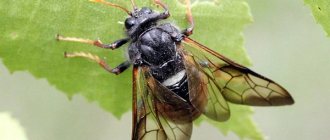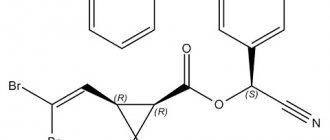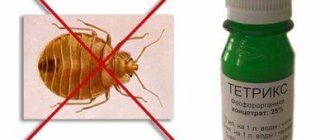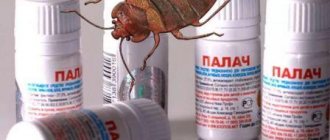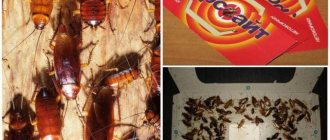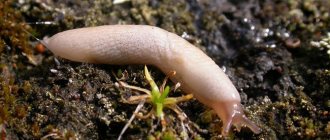Bedbugs are small blood-sucking insects. They are not only unpleasant in appearance, but also cause itchy wounds. In addition, bedbugs are dangerous because, crawling from one home to another, they are carriers of dangerous infectious diseases. At the first suspicion that parasites have appeared in the house, you need to start fighting them. The right choice of means will help you achieve success in this fight.
Chlorophos is a reliable ally in the fight against bedbugs
Today, the industry offers various means to combat blood-sucking insects, the presence of which deprives a person of a quiet life and causes serious harm to health. One of the most effective remedies is chlorophos.
Chlorophos is an organophosphorus compound from a group of insecticides used to kill insects. The basis of the drug was phosphoric acid combined with organic substances.
Externally, chlorophos looks like a white powder consisting of crystals. A characteristic feature is its pungent odor. It is not used in its pure form for treating premises.
The insecticide is offered to consumers in several versions:
- powdery;
- dissolved in water;
- pasty;
- concentrated emulsion;
- aerosol;
- wax based pencil.
Any type of drug is dangerous for bedbugs and helps clean your home from harmful insects.
The hazard class of substances created on the basis of chlorophos is 2. All of them are moderately dangerous and require caution and compliance with the rules for working with the drug.
Composition and release form of the product "Chlorophos"
The initial form of the drug is considered to be a white crystalline powder. The technical product is produced in the form of a gray mass of viscous consistency. It mixes easily with water and organic solvents. The active ingredient is considered to be chlorophos, which is present in the drug in a concentration of 97%.
The composition decomposes under the influence of alkalis and direct rays of the sun. Insecticide can be purchased at a hardware store. There are several main forms of release of the substance - paste, concentrated emulsion, wettable powder.
To make a solution or paste from Chlorophos, you must use an enamel or glass container. The product is destroyed in a metal container.
How does the chemical affect bedbugs?
Chlorophos is very toxic; interaction with the substance is destructive for insects.
Routes of entry of insecticide into the body of insects.
With food
If a bug eats a minimal amount of food soaked in a chlorophos solution, the poison enters the intestines and then into the blood of the insect.
Upon contact
Upon direct contact of any part of the body of parasites with the substance, the insecticide permeates the membrane and passes through it into the body, and then also enters the blood.
While breathing
Even if the bug did not come into direct contact with chlorophos, in the room treated with the drug, the insecticide will end up in its respiratory tract.
Regardless of where the substance ends up, it has a paralyzing effect on the insect’s nervous system. Then the immobilized parasite soon dies.
Use in everyday life
“Spraying” chlorophos on mosquitoes and flies is a harmful relic. In everyday life, electric fumigators are much more effective and harmless; in nature - repellents (at least the same old and well-tested dibutyl phthalate). In everyday life, chlorophos is used against insects by spraying the nests and migration routes of bloodsuckers (primarily bed bugs), and poisoned baits are effective against parasites (flies, cockroaches).
See below for the dosage of chlorophos against bedbugs, but the main thing here is to correctly “calculate” bedbugs. The fight against domestic vampires is a separate topic, but what mistakes should not be made in this case, see the video:
Video: mistakes when fighting bedbugs
Baits poisoned with chlorophos are prepared from working solutions sweetened with sugar. Porous products that are attractive to parasites are impregnated with poison and laid out on saucers, old can lids, etc. small vessels in places where insects appear most often. Baits for small flies and ants can be sweetened with jam or fruit syrup.
Dosages
The concentrations of working chlorophos suspensions are different for different types of pests. This is explained not only by the desire to minimize the harmful effects of DV on people, but also by the fact that an inappropriate concentration can create a drug-resistant population of the target to be eliminated. For the most common synanthropic insects, the concentrations of chlorophos solutions are as follows:
- Cockroaches, fly larvae and gamasid (sucking) mites – 2%.
- Winged flies (imago) – 0.5% for small ones and 1% for large ones (gray and blue meat flies).
- Synanthropic (house) ants – 0.1%.
- Bed bugs – 0.5%.
- Fleas and scabies mites – 1%.
The detected fly larvae (maggots) are sprayed with the solution. If after a trip to the forest a tick(s) is found on the body, moisten it/them with a cotton wool soaked in a solution of the drug. After this, you need to contact a parasitologist to remove the dead arthropod, if the tick itself has not fallen off, and to examine the victim, because the tick stylet remaining in the body can cause severe suppuration.
Chlorophos is not used against fleas and scabies mites on humans. Infected small animals and poultry are bathed in a chlorophos solution, immersed in it for 1-3 s. with the head. To disinfect pigs, small and large livestock, you need to contact a veterinarian.
Note: when bathing an animal, do not keep it in the solution. If he chokes, death is inevitable due to a sharp imbalance in the salt balance in the body. Cats should not be bathed with their heads at all - they will immediately choke.
Dose calculation
Technical chlorophos is produced with different AI contents from 65% to 98%. Data for calculating the amount of commercial drug required to obtain a working solution of a given concentration are given in the table:
Methods for preparing the solution
Concentrated emulsion (10%)
To prepare an aqueous solution based on a concentrated emulsion, you need to add 1 part of the emulsion to 4 parts of water. After thoroughly stirring the concentrate, the solution is ready for use.
Powder
A 1% chlorophos solution is prepared from the powder for treating rooms against bedbugs. In special cases, when insects are widespread, it is allowed to increase the concentration of the insecticide by 2 times.
Composition of the solution: add 10 g (to obtain a 2% solution - 20 g) of powder to 1 liter of water and stir until completely dissolved.
Paste
When using chlorophos in a paste form, add 15 g of paste to 1 liter of water and dilute it in liquid.
IMPORTANT: the solution is prepared immediately before treatment. The insecticide is brought to complete dissolution in water only in ventilated areas, with open windows or in the open air. The work is carried out in special clothing.
Aqueous solutions are applied to surfaces with a brush or sprayed. Pieces of furniture must be disassembled to process all parts, cracks and joints.
Excerpt characterizing Chlorophos
The Rostovs praised her taste and dress, and, taking care of her hair and dresses, at eleven o'clock they settled into their carriages and drove off. Since the morning of that day, Natasha had not had a minute of freedom, and not once had time to think about what lay ahead of her. In the damp, cold air, in the cramped and incomplete darkness of the swaying carriage, for the first time she vividly imagined what awaited her there, at the ball, in the illuminated halls - music, flowers, dancing, the sovereign, all the brilliant youth of St. Petersburg. What awaited her was so beautiful that she did not even believe that it would happen: it was so incongruous with the impression of cold, cramped space and darkness of the carriage. She understood everything that awaited her only when, having walked along the red cloth of the entrance, she entered the entryway, took off her fur coat and walked next to Sonya in front of her mother between the flowers along the illuminated stairs. Only then did she remember how she had to behave at the ball and tried to adopt the majestic manner that she considered necessary for a girl at the ball. But fortunately for her, she felt that her eyes were running wild: she saw nothing clearly, her pulse beat a hundred times a minute, and the blood began to pound at her heart. She could not accept the manner that would make her funny, and she walked, frozen with excitement and trying with all her might to hide it. And this was the very manner that suited her most of all. In front and behind them, talking just as quietly and also in ball gowns, guests entered. The mirrors along the stairs reflected ladies in white, blue, pink dresses, with diamonds and pearls on their open arms and necks.
Working with the drug requires caution
Chlorophos is toxic not only to bedbugs. The drug is also unsafe for humans. Therefore, its use requires extreme caution.
Only people who do not have diseases of the respiratory tract, cardiovascular system, or problems with blood circulation can work with the substance.
For protection you cannot do without personal means. Work is carried out only in rubber gloves and clothing specially designated for this (robe, trouser suit). Given the volatility of the drug, contact with the eyes and respiratory system should be prevented. For this purpose, safety glasses and a respirator are used.
All work with chlorophos is carried out only in these body protection items. After finishing the treatment, you must thoroughly wash your hands and face. To cleanse the respiratory tract, rinse your mouth.
If, after treating the premises, a person develops signs of chlorophos poisoning (feelings of headache, nausea, weakness, other unpleasant feelings), you should seek medical help.
Safety precautions
When using the substance, the following rules must be observed:
- In residential buildings, use the composition only in empty rooms. In this case, all family members need to move to another place for 2-3 days.
- To prevent the person handling the premises from being poisoned by harmful substances, he must use special clothing. To do this, it is permissible to use gloves, a respirator, a gas mask, and a gown.
- People who have pathologies of the cardiovascular system or disorders in the functioning of the circulatory system cannot work with the substance.
- Before using Chlorophos, the room must be cleared of dishes, clothing, and documents. It is also necessary to remove personal hygiene products and food products.
- If there are children in the house, it is recommended to put all things, food and toys in sealed bags. After treating the room, they should be rinsed thoroughly.
- After using chemicals, you must immediately remove all protective clothing. In this case, it is recommended to wash your face and hands thoroughly with water and soap. The mouth and nose should be rinsed with water.
- After finishing work, you must leave the apartment immediately. A couple of hours after treatment, the room needs to be thoroughly ventilated. After 2 days, the room must be thoroughly treated. At the same time, wet cleaning is carried out.
- A glass or ceramic container is suitable for storing the drug. It must be kept in a dry place, away from people. Making the solution for future use is prohibited.
Advantages of the drug
The effective result of using chlorophos is ensured by the benefits this substance has.
- Chlorophos is a fast-acting drug. And already within 10 minutes. from the moment of treatment, 50% of insects die. The rest of the bedbugs in the room will die in the next 60 minutes.
- The drug destroys not only adult individuals, it is equally dangerous and effective when it comes into contact with the larvae or eggs of bedbugs, destroying the entire colony of insects that have settled in the home.
- Due to its volatility and transformation into vapor, chlorophos has an effect even on insects that do not have contact with it. The vapors of the drug have the same toxic properties as the solution.
Instructions for use
The drug is sold in powder form. The product dissolves well in water and has a specific odor. The composition is applied by spraying or watering. You first need to make a working solution. Its concentration depends on the type of parasite.
At normal temperature parameters, residual activity persists for 2-3 weeks. However, if the readings increase to +28 degrees or more, the effect of the product will end after 1 week.
See also
Instructions for use of Vofatox, dosage of insecticide and analoguesRead
Against bedbugs
To cope with bedbugs, it is recommended to use an aqueous solution of technical "Chlorophos". Its concentration can be 0.5-2%. To eliminate parasites, you need to irrigate cracks, beds, and sofas. It is imperative to treat areas behind the baseboards. The dosage of the product should be 50-100 milliliters per 1 square meter of surface.
For fleas
To combat fleas and prevent their attacks, it is worth using technical “Chlorophos”. It is produced in the form of an aqueous solution with a concentration of 1%.
If it is necessary to destroy fleas in rooms, it is necessary to treat beds, sofas, and floors. It is also necessary to work on walls 1 meter high. Careful processing of skirting boards is of great importance. For 1 square meter of area, 50-100 milliliters of product are required.
To kill ants
To combat ants, you need to use a composition with a concentration of 0.1%. In this case, it is important to influence the movement paths of working individuals. For 1 square meter of surface, 25 milliliters of solution are required.
Cockroaches
To cope with cockroaches, it is worth using technical "Chlorophos". Its concentration should be 2%. For 1 square meter of surface you need to use 100 milliliters of product.
In this case, it is necessary to treat all areas where cockroaches live, paying attention to cracks, holes, trunks, and cabinets.
It is of no small importance to apply the solution to door and window jambs, as well as baseboards.
To achieve maximum results, it is necessary to simultaneously treat all cockroach localization zones in each room of the building.
Rat ticks
To combat rat mites, it is recommended to use a Chlorophos solution with a concentration of 3%. At the same time, it is worth treating kitchens, bathrooms, and toilets. Of no small importance is the impact on the baseboards around the perimeter of the premises.
Expert opinion
Zarechny Maxim Valerievich
Agronomist with 12 years of experience. Our best country expert.
Ask a Question
It is also necessary to treat floors near heating sources, ventilation holes, and sewer risers.
Scabies mites
To destroy scabies mites, you need to properly prepare the working solution. To do this, it is recommended to use 11 grams of the substance per 1 liter of water.
Mosquito imago
To cope with winged mosquitoes, it is recommended to use an aqueous solution of technical "Chlorophos". Its concentration is 2%. In this case, it is necessary to treat the external surfaces of buildings, sheds and other areas where mosquitoes may be present.
Mosquito larvae
To combat mosquito larvae in small bodies of water - ditches, pits, vats - in populated areas, it is necessary to irrigate water surfaces with a solution made from technical "Chlorophos". Its concentration should be 1-3%. Since the composition is highly soluble in water, its amount is calculated taking into account the volume of liquid. 1-3 grams of the drug are required per 1 cubic meter.
See also
Instructions for use and composition of Aversectin, consumption rates and analoguesRead
Adult flies
The dosage of Chlorophos in this case depends on the size of the insects. For small pests, a concentration of 0.5% will be sufficient. For large parasites, such as blue flies, a 1% Chlorophos solution is required.
Fly larvae
To cope with fly larvae, you need to use an aqueous solution of the product, the concentration of which is 2%.
Disadvantages of the insecticide
The disadvantages of chlorophos are associated with its main quality and advantage - toxicity.
When working, you need to pay attention to the following features of the substance, which are considered its disadvantages.
Toxicity
Due to its high toxicity, when working with chlorophos, increased safety measures, great care and caution are required. Preliminary preparation of the room for processing is also necessary:
- clearing the area to be cleaned of all residents (adults, children, animals) during the immediate treatment and after it (you can return to your home 2-3 days after treatment);
- removal from the room (or sealed packaging) of food products, things, toys, decorative items, etc.
Need for cleaning
Thorough cleaning of rooms after using chlorophos:
- 3 hours after treatment - mandatory long-term ventilation (at least 3 hours);
- After 48 hours, wash surfaces with an alkaline solution that neutralizes the drug. To make a solution, just add baking soda to water.
Smell
The pungent odor of the insecticide and its persistence are also considered a disadvantage of the substance. Even after cleaning and ventilation, the residual smell of chlorophos can be felt for 1 (less often 2) weeks.
IMPORTANT: the period of active influence of the drug applied for treatment on insects is 4 days.
Composition and action
Chlorophos is the technical name for O,O-dimethyl-(2, 2, 2-trichloro-1-oxyethyl)-phosphonate, a phosphonic acid derivative belonging to the class of organophosphorus compounds (OPS). In terms of action, this substance, like other OPs, is a neurotoxin (nerve poison). Chlorophos blocks acetylcholine receptors in the intermediate ganglia of nerve cells, the central nervous system loses the ability to control the body; the result is paralysis, disruption of internal organs and death. This mechanism of action, on the one hand, ensures the speed and completeness of destruction of the pest population - when treated with the drug, they almost instantly stop their normal activity and do not have time to crawl. On the other hand, the use of chlorophos also has a prolonged effect: those who do not immediately “grab” an absolutely lethal dose are still either doomed to death within hours or days, or lose the ability to feed and reproduce.
The particular strength and speed of action of chlorophos on insects is due to the fact that the original DV (active substance) in their body is very quickly hydrolyzed to DDVP (dichlorvos), which is much more toxic, see figure:
In the body of vertebrates, hydrolysis of DV occurs in a different way, so chlorophos is less dangerous for humans and warm-blooded animals. Chlorophos is moderately dangerous for bees, because its contact effect is insignificant; it is more of an intestinal poison. At the same time, the systemic effect of chlorophos on plants is high; it quickly permeates all their tissues and disintegrates there in 7-14 days, but almost does not get into nectar and pollen. That is, chlorophos as a pesticide is effective against gnawing and sucking pests, and honey bees do not bite into plant tissue.
Note: the metabolism of arachnids, which includes mites, is significantly different than that of insects, therefore chlorophos is less effective as an acaricide.
But you still shouldn’t joke with him
Working fluids (suspensions) of chlorophos are unstable in light and open air. In a slightly alkaline environment, the active substance of the drug is neutralized almost instantly. However, precautions when working with chlorophos (see below) should be strictly observed, because:
- The drug easily penetrates the body of warm-blooded animals by reabsorption of fat.
- Chronic chlorophos poisoning is asymptomatic; if signs of acute intoxication are noticed (see below), you need to be treated.
- Chlorophos has a pronounced cumulative effect: a number of minor poisonings can suddenly turn into acute ones.
- Accumulation of active substances of the drug in the body is possible both through direct contact with it and as a result of consumption of products from processed objects (fruits, meat, milk, eggs).
- There is no specific antidote (antidote) for chlorophos; treatment is symptomatic, in no way guaranteeing against long-term post-effects.
- For chlorophos, blastomogenic activity has been precisely established, i.e. ability to cause tumors. Not necessarily malignant, but removal of even such seemingly harmless tumors as fatty tumors is fraught with the risk of developing aggressive cancer.
Preparative forms
Chlorophos for household use is available in the form of ready-to-use sprays containing a weak suspension of the drug, but chlorophos cans are only suitable for “shooting at” winged, annoying insects. For professional use, a paste-like preparation is produced (from it a working stable solution with an adhesive is quickly prepared), however, working with chlorophos paste requires expensive professional PPE, because The paste that gets on the skin is absorbed into the body immediately. For independent use against insects, chlorophos is produced in the form of a wettable powder (see the figure at the very beginning) in packaging from 0.2 to 5 kg. Powder that gets on the body or spills can be easily neutralized with improvised means, see below, and ready-made working fluids from it are effective against all phases of pest development, incl. eggs in a soft shell and resting larval stages (pupae, puparia flies).
Storage rules
To preserve the inherent properties of the substance, the necessary storage conditions for the drug should be provided.
Tips for storing chlorophos:
- after opening and using the required amount of the substance, the packaging must be carefully and tightly closed;
- to ensure safety, the drug is stored in rooms with good ventilation;
- the optimal temperature for preserving the shelf life of the substance is +20°;
- It is allowed to store the drug only in the forms in which it was purchased.
IMPORTANT: prepare an aqueous solution in advance and do not store the prepared or unused solution!
Safety for children and animals
Undesirable consequences for children and animals can be avoided by following simple rules:
- the place where the substance is stored must be inaccessible to children and animals;
- carrying out processing only in the absence of children and animals in the room;
- removal of all children's things, toys, pet food before treatment begins;
- return of children and animals only after thorough ventilation and wet cleaning of all surfaces in the rooms with an alkaline solution;
TIP: It is not recommended to use a toxic product in rooms with newborns or infants.
Where to buy the drug?
You can purchase the substance in stores specializing in the sale of household goods, gardening stores, or markets.
Many online stores also offer the insecticide in a variety of forms.
The main thing when buying a drug is to be confident in its quality. Purchasing from small traders or purchasing the drug secondhand in temporary markets does not guarantee this. Unscrupulous traders sell expired substances, the use of which will not produce results, or powders of dubious composition.
Therefore, it is recommended to buy chlorophos only from trusted sellers.
Chlorophos will not only help get rid of harmful insects. He will make the home an impregnable fortress for them.
Similar articles:
- We get rid of bedbugs using the German remedy “Executioner”. How to use the drug, where it can be purchased, customer reviews
- We destroy bedbugs using Cucaracha: we analyze the composition, find out how it affects the insect. Instructions for using the chemical and preliminary preparation of housing
- We destroy bedbugs using cold fog: the essence of the method, its effectiveness, safety measures, review of the most popular manufacturers
- Is using Clean House spray with chamomile effective against house bugs? Instructions for use

